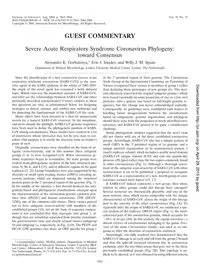
2004 Severe Acute Respiratory Syndrome Coronavirus Phylogeny_ toward Consensus PDF
Preview 2004 Severe Acute Respiratory Syndrome Coronavirus Phylogeny_ toward Consensus
JOURNAL OF VIROLOGY, Aug. 2004, p. 7863–7866 Vol. 78, No. 15 0022-538X/04/$08.00�0 DOI: 10.1128/JVI.78.15.7863–7866.2004 Copyright © 2004, American Society for Microbiology. All Rights Reserved. GUEST COMMENTARY Severe Acute Respiratory Syndrome Coronavirus Phylogeny: toward Consensus Alexander E. Gorbalenya,* Eric J. Snijder, and Willy J. M. Spaan Department of Medical Microbiology, Leiden University Medical Center, Leiden, The Netherlands Since the identification of a new coronavirus (severe acute respiratory syndrome coronavirus [SARS-CoV]) as the caus- ative agent of the SARS epidemic in the winter of 2002-2003, the origin of the novel agent has remained a hotly debated topic. Which virus was the immediate ancestor of SARS-CoV, and what are the relationships between SARS-CoV and other previously described coronaviruses? Correct answers to these two questions are vital, as substantiated below, for designing strategies to detect, contain, and combat new outbreaks and for dissecting the fundamentals of the SARS-CoV life cycle. Major efforts have been invested in a thus far unsuccessful search for a natural SARS-CoV reservoir. In the meantime, and more outside the spotlight, SARS-CoV genome sequences have been used to define the phylogenetic position of SARS- CoV among coronaviruses. These studies have resulted in a lot of controversy whose intricacies may not be very clear to out- siders. Our purpose is to clarify the situation from an insider’s point of view. Originally, coronaviruses were classified on the basis of an- tigenic cross-reactivity, and in this manner three antigenic groups (1 to 3) were recognized (14). When coronavirus ge- nome sequences began to accumulate, the same groups were evident from phylogenetic analyses of the four structural pro- teins, N, M, E, and S (19), and of different regions of the giant replicase (3, 22). Group boundaries were also supported by the diversity of small open reading frames (ORFs) encoding ac- cessory proteins, which are dispersed among the structural protein genes in the 3�-proximal region of the genome (Fig. 1). In the middle of the nineties, a first discord between the anti- genicity-based and phylogenetic classifications emerged upon the characterization of the coronavirus porcine epidemic diar- rhea virus (PEDV) and human coronavirus 229E (HCoV- 229E), one of the common cold viruses. These viruses proved not to have antigenic cross-reactivity with members of the established groups (18), yet on the basis of sequence compar- isons it was concluded that they segregate into group 1, al- though they are somewhat separated from porcine transmissi- ble gastroenteritis virus and closely related viruses (subgroup 1b and subgroup 1a, respectively, in Fig. 2) (9). The PEDV and HCoV-229E genomes also share an ORF specific for group 1 in the 3�-proximal region of their genome. The Coronavirus Study Group of the International Committee on Taxonomy of Viruses recognized these viruses as members of group 1 rather than declaring them prototypes of new groups (6). This deci- sion effectively converted the original antigenic groups—which were based essentially on some properties of one or a few viral proteins—into a genetic one based on full-length genome se- quences, but this change was never acknowledged explicitly. Consequently, no guidelines were established with respect to handling future disagreements between the classifications based on antigenicity, genome organization, and phylogeny should these arise from the properties of newly identified coro- naviruses, and SARS-CoV proved to be quite a classification challenge. Initial phylogenetic analyses suggested that the novel virus did not cluster with any of the three established coronavirus groups. Accordingly, SARS-CoV also has a unique pattern of small ORFs in the 3�-proximal region of its genome and a unique internal organization of its nonstructural protein 3 (nsp3) replicase subunit, which includes a sizable novel domain (SARS-CoV unique domain SUD) and only one papain-like protease (PL2pro) rather than the two copies commonly found in other coronaviruses (Fig. 1). Although a thorough assess- ment of the antigenic cross-reactivity of SARS-CoV with other coronaviruses is yet to be published, a proposal to recognize SARS-CoV as a representative of a new, fourth group of coro- naviruses seemed most logical (15, 17). If SARS-CoV indeed represents a new group, then when, relative to other groups, could this lineage have emerged? Several scenarios are theoretically plausible, and one of the most extreme ones, which seems compatible with the unique characteristics of SARS-CoV, places the origin of this lineage next to the ancestor of the other coronaviruses (Fig. 2A). To rigorously infer the origin of SARS-CoV, we conducted a spe- cial analysis of the replicase ORF1b region (Fig. 1), the most- conserved part of the coronavirus genome, which accounts for �20% of its size (20). In this analysis, the equine torovirus—a distant relative of coronaviruses belonging to the genus Toro- virus of the same Coronaviridae family—was used as an out- group to infer the direction of coronavirus evolution. Surprisingly, our fully resolved tree demonstrated that the SARS-CoV lineage is an early split-off from the group 2 branch and that the split-off occurred relatively late in coronavirus evolution, after the two bifurcations that gave rise to the three previously established groups (Fig. 2B). This topology is un- likely to be skewed, as it was obtained by using different criteria * Corresponding author. Mailing address: Department of Medical Microbiology, Center of Infectious Diseases, Leiden University Med- ical Center, Albinusdreef 2, E4-P, Room L04-036, 2333 ZA Leiden, The Netherlands. Phone: 31-71-526-1652. Fax: 31-71-526-6761. E-mail:
